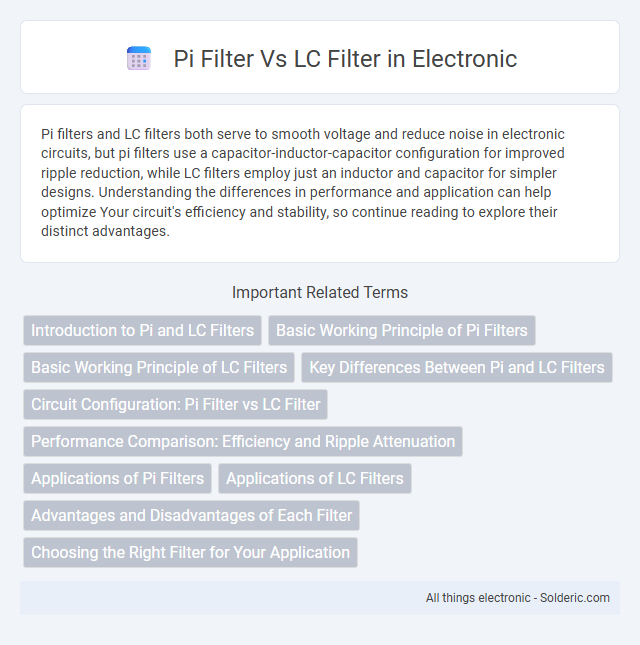Pi filters and LC filters both serve to smooth voltage and reduce noise in electronic circuits, but pi filters use a capacitor-inductor-capacitor configuration for improved ripple reduction, while LC filters employ just an inductor and capacitor for simpler designs. Understanding the differences in performance and application can help optimize Your circuit's efficiency and stability, so continue reading to explore their distinct advantages.
Comparison Table
| Feature | Pi Filter | LC Filter |
|---|---|---|
| Configuration | Capacitor - Inductor - Capacitor | Inductor - Capacitor |
| Ripple Reduction | High | Moderate to High |
| Complexity | More complex | Simpler |
| Size | Larger due to two capacitors and one inductor | Smaller with fewer components |
| Cost | Higher cost | Lower cost |
| Applications | Power supplies requiring low ripple voltage | Basic power filtering and noise reduction |
| Effectiveness | Better smoothing of DC output | Good but less effective than Pi filter in ripple suppression |
Introduction to Pi and LC Filters
Pi filters consist of two capacitors and one inductor arranged in a p-shaped configuration, offering efficient voltage smoothing and noise reduction in power supplies. LC filters use a simpler series combination of an inductor and capacitor, primarily targeting ripple attenuation and high-frequency noise suppression. Understanding the differences helps you select the optimal filter for your specific electronic circuit requirements.
Basic Working Principle of Pi Filters
Pi filters operate by using a capacitor-inductor-capacitor configuration to reduce voltage ripple in power supplies, with capacitors providing high-frequency noise attenuation and the inductor blocking AC components while allowing DC to pass. The first capacitor shunts high-frequency noise to ground, the inductor smooths the current by opposing rapid changes, and the second capacitor further filters residual ripple before output. This arrangement enhances voltage stability and ripple suppression compared to simpler filter types.
Basic Working Principle of LC Filters
LC filters operate by combining inductors (L) and capacitors (C) to create a resonant circuit that selectively allows signals of certain frequencies to pass while attenuating others. The inductor resists changes in current, and the capacitor resists changes in voltage, enabling the filter to smooth voltage fluctuations and suppress high-frequency noise effectively. This resonant interaction enhances signal purity in power supplies and communication systems by blocking unwanted harmonics and ripple frequencies.
Key Differences Between Pi and LC Filters
Pi filters consist of two capacitors with an inductor sandwiched between, providing superior voltage ripple reduction compared to LC filters, which use only one inductor and one capacitor. LC filters offer simpler design and are more compact but typically deliver less effective noise suppression and ripple attenuation than pi filters. Your choice depends on the required filtering performance, circuit complexity, and available space.
Circuit Configuration: Pi Filter vs LC Filter
Pi filters consist of two capacitors and one inductor arranged in a p-shaped configuration to provide effective voltage smoothing and noise reduction in power supplies. LC filters typically use a single inductor followed by a capacitor or vice versa, forming a simpler series circuit with fewer components but less attenuation of high-frequency noise compared to pi filters. Your choice between a pi filter and an LC filter depends on the desired level of ripple reduction and circuit complexity.
Performance Comparison: Efficiency and Ripple Attenuation
Pi filters generally offer higher ripple attenuation due to their three-element design combining capacitors and an inductor, making them more effective at smoothing voltage output and improving overall efficiency in power supplies. LC filters, consisting of a simple inductor-capacitor pair, provide good efficiency with lower component cost but typically yield less ripple suppression compared to Pi filters. In high-frequency applications, Pi filters outperform LC filters by offering superior noise reduction and enhanced voltage regulation stability.
Applications of Pi Filters
Pi filters are extensively used in power supplies for smoothing DC voltage by reducing ripple voltage and electromagnetic interference, making them ideal for audio equipment and radio frequency applications. Their design, consisting of two capacitors and an inductor, provides superior noise suppression compared to simpler LC filters, enhancing the stability of sensitive electronics. Your choice of a pi filter ensures consistent performance in environments requiring clean, stable power delivery.
Applications of LC Filters
LC filters are widely used in RF circuits, power supplies, and audio equipment to reduce noise and unwanted harmonics, ensuring signal integrity and improved performance. Their ability to handle higher frequencies and provide sharper cutoff compared to pi filters makes them ideal for applications requiring precise frequency selection or suppression. You benefit from LC filters' superior efficiency in transmitting desired signals while minimizing interference in communication systems and signal processing devices.
Advantages and Disadvantages of Each Filter
Pi filters offer superior voltage regulation and reduced ripple voltage due to their combination of capacitors and inductors, making them ideal for power supply smoothing in electronic circuits. However, they tend to be larger, more expensive, and heavier than LC filters, posing challenges for compact or cost-sensitive applications. LC filters provide simpler design and lower cost with effective filtering for high-frequency noise but may exhibit less ripple reduction and voltage stability compared to pi filters under varying load conditions.
Choosing the Right Filter for Your Application
Selecting between a Pi filter and an LC filter depends on the specific needs of your application, such as frequency range, impedance levels, and required attenuation. Pi filters excel in providing high attenuation for ripple voltage in power supplies due to their capacitive-inductive-capacitive configuration, making them ideal for low-frequency noise suppression. LC filters offer improved performance in high-frequency signal filtering with lower insertion loss, making them suitable for RF circuits and audio applications where signal integrity is critical.
pi filter vs LC filter Infographic

 solderic.com
solderic.com